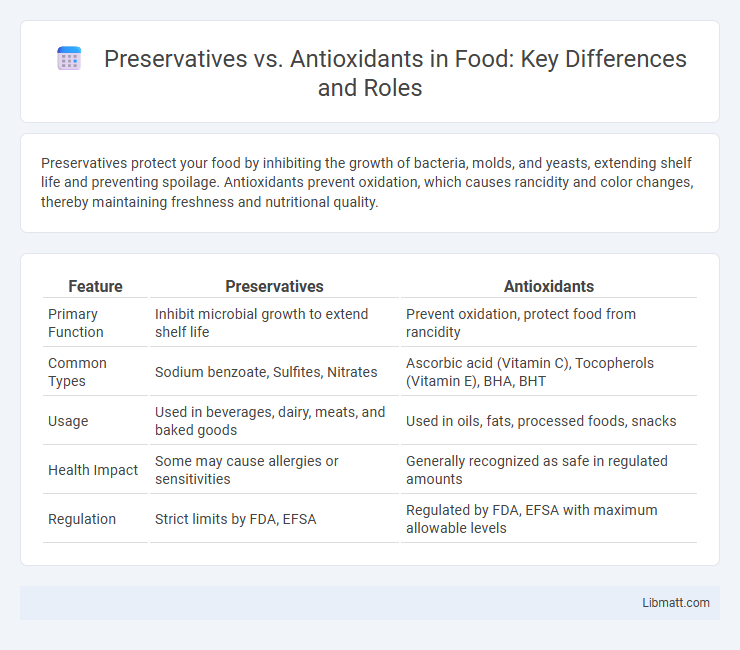Preservatives protect your food by inhibiting the growth of bacteria, molds, and yeasts, extending shelf life and preventing spoilage. Antioxidants prevent oxidation, which causes rancidity and color changes, thereby maintaining freshness and nutritional quality.
Table of Comparison
| Feature | Preservatives | Antioxidants |
|---|---|---|
| Primary Function | Inhibit microbial growth to extend shelf life | Prevent oxidation, protect food from rancidity |
| Common Types | Sodium benzoate, Sulfites, Nitrates | Ascorbic acid (Vitamin C), Tocopherols (Vitamin E), BHA, BHT |
| Usage | Used in beverages, dairy, meats, and baked goods | Used in oils, fats, processed foods, snacks |
| Health Impact | Some may cause allergies or sensitivities | Generally recognized as safe in regulated amounts |
| Regulation | Strict limits by FDA, EFSA | Regulated by FDA, EFSA with maximum allowable levels |
Understanding Preservatives and Antioxidants
Preservatives are chemical agents used to inhibit the growth of bacteria, molds, and yeasts, thereby extending the shelf life of food and cosmetic products. Antioxidants prevent oxidation processes that cause spoilage, rancidity, and color changes by neutralizing free radicals in the product. Both preservatives and antioxidants play critical roles in maintaining product quality and safety, but they function through distinct mechanisms targeting microbial growth and chemical degradation respectively.
Key Differences Between Preservatives and Antioxidants
Preservatives primarily inhibit the growth of microorganisms such as bacteria, molds, and yeasts to extend the shelf life of products, while antioxidants prevent oxidation processes that cause rancidity and spoilage by neutralizing free radicals. Preservatives include agents like sodium benzoate and parabens, whereas antioxidants commonly involve compounds such as ascorbic acid (vitamin C) and tocopherols (vitamin E). The key difference lies in their mode of action: preservatives focus on microbial stability, whereas antioxidants target chemical stability by preserving the integrity of fats and oils.
How Preservatives Work in Food
Preservatives work in food by inhibiting the growth of bacteria, molds, and yeasts that cause spoilage and foodborne illnesses, thereby extending the shelf life and maintaining safety. They function through various mechanisms, such as altering pH levels, reducing moisture, or releasing antimicrobial compounds that disrupt microbial cell functions. Understanding how preservatives protect your food can help maintain freshness and prevent waste while ensuring that it remains safe to consume.
The Role of Antioxidants in Food Preservation
Antioxidants play a crucial role in food preservation by inhibiting oxidation, a primary cause of food spoilage that leads to rancidity and nutrient loss. They neutralize free radicals, thereby extending the shelf life and maintaining the quality of oils, fats, and other perishable ingredients. Common food antioxidants include ascorbic acid (vitamin C), tocopherols (vitamin E), and synthetic compounds like butylated hydroxytoluene (BHT), which protect against oxidative degradation more effectively than many traditional preservatives.
Common Types of Preservatives Used Today
Common types of preservatives used today include parabens, sulfites, benzoates, and formaldehyde releasers, which inhibit microbial growth and prolong shelf life in cosmetics, foods, and pharmaceuticals. Antioxidants like ascorbic acid (vitamin C), tocopherols (vitamin E), and BHA/BHT prevent oxidation, maintaining product freshness by neutralizing free radicals that cause spoilage and rancidity. Your choice between preservatives and antioxidants depends on the specific preservation needs and product formulation.
Popular Food Antioxidants and Their Sources
Popular food antioxidants include vitamin C (ascorbic acid) found in citrus fruits, vitamin E (tocopherols) present in nuts and seeds, and polyphenols abundant in berries, green tea, and dark chocolate. These antioxidants protect your food by neutralizing free radicals, preventing spoilage, and extending shelf life naturally. Incorporating antioxidant-rich foods helps maintain food quality while supporting health benefits related to oxidative stress reduction.
Health Impacts: Preservatives vs Antioxidants
Preservatives and antioxidants both play crucial roles in maintaining food quality, but their health impacts differ significantly. Preservatives, often synthetic chemicals like sodium benzoate or parabens, may cause allergic reactions or disrupt gut microbiota, whereas antioxidants such as vitamin C and E protect cells from oxidative stress and reduce inflammation. Your choice between these additives can influence long-term health, with antioxidants generally providing beneficial effects compared to the potential risks associated with some preservatives.
Natural Alternatives to Synthetic Preservatives
Natural alternatives to synthetic preservatives include antioxidants like vitamin E (tocopherol), rosemary extract, and green tea polyphenols, which help prevent oxidation and extend shelf life. These natural compounds inhibit microbial growth and oxidative rancidity, maintaining product freshness without harsh chemicals. You can choose formulations containing these natural preservatives to ensure safer, eco-friendly preservation.
Industry Regulations and Safety Concerns
Industry regulations for preservatives and antioxidants mandate strict safety evaluations to minimize health risks, with agencies such as the FDA and EFSA setting permissible usage limits based on toxicological data. Preservatives primarily inhibit microbial growth, requiring rigorous microbial efficacy testing, while antioxidants prevent oxidative degradation, emphasizing chemical stability and potential allergenicity assessments. Ongoing safety concerns center around potential long-term exposure effects, leading to continuous re-evaluation and reformulation to ensure compliance with evolving regulatory standards.
Choosing Between Preservatives and Antioxidants in Products
Choosing between preservatives and antioxidants in products depends on your goal of extending shelf life and maintaining quality. Preservatives primarily inhibit microbial growth, preventing spoilage and contamination, while antioxidants protect against oxidation, preserving color, flavor, and nutritional value. Selecting the right agent requires understanding the product's susceptibility to microbes or oxidative damage to ensure optimal protection and safety.
Preservatives vs Antioxidants Infographic

 libmatt.com
libmatt.com